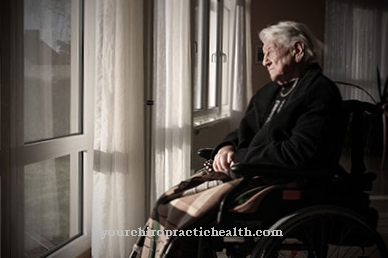Of the Pseudo croup, infectious croup or Subglottic laryngitis is a laryngitis that is more common in young children than in adults. The cause of this disease is a viral infection of the respiratory tract, which subsequently leads to a narrowing, so that the person affected sometimes suffers from shortness of breath and barking cough. Treatment by a doctor is recommended.
What is pseudo croup?

© Andrey Bandurenko - stock.adobe.com
Of the Pseudo croup is an inflammation that can be localized below the glottis and in the area of the larynx. Croup is a disease of the upper respiratory tract and manifests itself as hoarseness and a barking cough. In extreme situations it can also lead to shortness of breath.
The disease very often affects children and infants aged six months to six years. Adults and older children are less likely to be affected. Younger children are therefore more likely to develop pseudo croup, as their larynx is still relatively narrow in contrast to older children. The real croup is far more dangerous than the pseudo croup.
causes
While true croup is identical to larynx diphtheria, the Pseudo croup caused by parainfluenza viruses or, very rarely, by measles, rhino or RS viruses. According to this, the croup is a viral infection, as a result of which the larynx lining below the vocal cords becomes inflamed.
The resulting swelling and the thick mucus constrict the airways, which means that the patient gets poorer air. Due to the fact that the larynx is often still narrowed in small children and therefore swelling has a greater impact, it is mainly infants and toddlers who develop pseudo croup.
In addition, the weather also plays a certain role in the onset of the pseudocroup disease. Most cases of pseudo croup occur in autumn or winter and especially in damp, cold weather and when the upper layers of the air are warmer than the lower. If this is the case, one speaks of a so-called inversion weather situation, which favors the pseudo croup.
The scientists also suspect that there is a certain connection between the pollutant emissions of the industrial plants and the occurrence of the pseudocouple.
Symptoms, ailments & signs
A typical symptom of croup is a dry, barking cough that occurs like a fit in the evening or at night. The voice can become hoarse and there is difficulty breathing due to obstruction of the airways. Whistling or squeaking noises are heard when inhaling. Since the disease usually arises as a result of a cold, its typical symptoms such as runny nose or fever can also appear.
In addition, a general feeling of illness occurs, the patient feels tired and weak. If the shortness of breath increases, the lack of oxygen can cause the lips and fingertips to turn blue. An acceleration of the heartbeat (tachycardia) is also possible. Since these symptoms appear frightening, the patient becomes restless, which in turn can exacerbate the symptoms.
In adults, the symptoms are usually much less severe than in children. The symptoms indicate which stage the disease has reached. If only hoarseness and cough are present, stage 1. Stage 2 is characterized by quiet breathing sounds when inhaling, stage 3 by dyspnoea, tachycardia, anxiety and paleness. Stage 4 of the disease is when the shortness of breath becomes more severe, the pulse can only be felt very shallowly, breathing sounds are heard both when breathing in and when breathing out, the skin turns blue and consciousness is clouded.
Course of disease
At the Pseudo croup patients are plagued by a barking cough characteristic of this disease. Furthermore, a hoarseness in connection with a whistling noise occurring during inhalation is characteristic of the pseudo croup. If the larynx is severely narrowed as a result of the swelling and inflammation, severe shortness of breath can also occur in pseudo croup, which very often manifests itself in very strained breathing and a retraction of the thrombus and the intercostal spaces.
If the oxygen supply is so disturbed as a result of shortness of breath in pseudo croup, the fingernails and lips can turn blue and, in rare cases, palpitations can occur. A sudden appearance at night is typical for the croup.
Complications
Most cases of croup heal without complications. If the course is severe, however, it is possible that the airways become extremely narrow. Breathing becomes so strenuous for the person concerned that he pulls in the intercostal spaces and the throttle pit. If the obstruction of the airways ultimately leads to an inadequate supply of oxygen to the body and brain, the heart starts racing, then the lips and fingernails turn bluish.
The shortness of breath usually causes great fear for those affected, who are usually small children. The resulting panic makes the original symptoms even worse. Under these circumstances, the disease can become life-threatening and, in rare cases, be fatal. This is especially true if the disease breaks out at night without warning. Then there is a risk that the children will not receive medical treatment in good time.
In rare cases, croup infection can spread to the middle ear, trachea, or lungs. Then there is a risk of acute otitis media, tracheitis (windpipe inflammation) or pneumonia (pneumonia). These diseases can usually all be treated very well. However, further complications from these secondary diseases are possible.
You can find your medication here
➔ Medicines against coughs and coldsWhen should you go to the doctor?
If the typical whistling noise occurs when you breathe in, often associated with hoarseness and sore throat, you may have pseudo croup. Before this, signs of a cold with fever and chills may occur in connection with the disease. If the symptoms do not go away quickly, a doctor should be consulted. Medical advice is required at the latest when the lips and facial skin turn bluish. A very high fever indicates another illness that needs to be clarified by a doctor. The pseudo croup occurs mainly after a viral infection with measles or influenza viruses.
Babies and toddlers as well as adults with chronic respiratory diseases are particularly affected. Those at risk should see a doctor quickly with the symptoms mentioned. If the symptoms occur in connection with cold air, cigarette smoke or environmental toxins, a pseudo croup may also be the reason. It is best for those affected to contact their family doctor or an ENT doctor. Depending on the severity of the disease, other respiratory specialists may need to be involved in the treatment.
Treatment & Therapy
Is at Pseudo croup the shortness of breath is particularly threatening, the mucous membrane can be made to swell very quickly by the nebulization with adrenaline and thus alleviate the symptoms of croup. Furthermore, cortisone preparations, such as prednisone, are very often prescribed for pseudocroup. In pseudocroup, these are administered either as suppositories into the anus or, much less often, via a venous access.
If the pseudo croup patient is in an extremely bad condition, he or she must be transferred to a hospital, where a so-called endotracheal intubation is usually carried out under general anesthesia for the pseudo croup. A hollow probe, mostly made of plastic, is inserted through the vocal folds on the larynx into the trachea either through the nose or the mouth. The airways are sealed with the help of a balloon, which prevents secretions from entering. This means that external ventilation of the pseudo croup patient is now possible.
Aftercare
Pseudocroup usually runs with mild symptoms and heals completely within three to five days. Severe manifestations often require inpatient treatment. In these cases, doctors administer adrenaline for inhalation and high doses of glucocorticoids, and in the case of respiratory insufficiency, oxygen is given. Outpatient follow-up care includes regular routine checks to assess the general condition and to initiate appropriate therapy if symptoms increase.
Parents should always contact the doctor who will follow up if they have difficulty swallowing, if the fever lasts for more than three days or if signs of breathlessness reappear. There are also self-help groups and parents' initiatives on the topic of croup syndrome for relatives. Many useful tips make dealing with the respiratory infection easier.
Here, too, the doctor can name the right contact person. As part of aftercare, advice centers offer the opportunity to exchange ideas about pseudo croup, receive suggestions for therapeutic measures and benefit from the experiences of other parents. Since a pseudo croup attack can recur in children, treatment recommendations by doctors and specialists are particularly important.
This applies, for example, to the correct way of dealing with a recurring pseudo croup attack. Insured persons can also obtain competent information about the viral Krupp via the telephone service center of their health insurance company. Experts such as medical specialists, qualified nurses and nutrition coaches on the medical hotlines provide specific information and valuable guidance on all questions related to the pseudo croup on 365 days.
You can do that yourself
A pseudo croup attack is a burden for both parents and child. As a parent, it is important to keep calm and keep your own nervousness away from the coughing child: Hustle and bustle and stress can trigger a panic attack under certain circumstances, which makes the shortness of breath worse. During an acute attack, parents should therefore calm the child down and try to distract them as much as possible by doing something together. In the event of severe pain or clouding of consciousness, a doctor must be consulted immediately.
As a home remedy, cool, damp neck wraps have proven to be effective in preventing further swelling of the mucous membranes around the larynx. Alternatively, ice cubes wrapped in a cloth can be used. Drinking tea or still mineral water in small sips can also have a soothing effect: However, parents must make sure that the child does not choke on them.
As a preventive measure, it is advisable to keep the room air as cool and humid as possible. Especially in the evening, damp cloths can be hung up in the children's room or air humidifiers can be attached to the heater. In addition, children suffering from pseudo croup should spend as much time outdoors as possible, salty air by the sea brings long-term relief in many cases. In addition, a balanced diet rich in vitamins helps to strengthen the immune system.

.jpg)


.jpg)




















.jpg)


